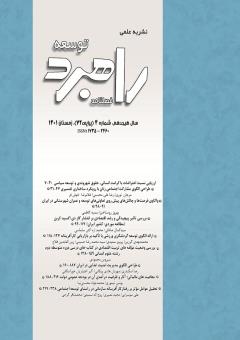طراحی الگوی مشارکت اجتماعی زنان با رویکرد ساختاری تفسیری
محورهای موضوعی :
رضاعلی محسنی
1
,
غلامرضا خوش فر
2
![]() ,
مرجان نوری
3
,
مرجان نوری
3
1 - 0
2 - دانشگاه گلستان، دانشکده علوم انسانی و اجتماعی، گروه جامعه شناسی
3 - 0
کلید واژه: واژگان کلیدی: مشارکت اجتماعی, تحلیل محتوا, ساختاري تفسیري.,
چکیده مقاله :
مشارکت حقی است که باید برای همگان فراهم شود و از بنیانهای مهم روابط اجتماعی است و زنان به عنوان نیمی از جمعیت جامعه با مشارکت اجتماعی میتوانند نقش مهمی در توسعه جوامع داشته باشند. از اینرو هدف پژوهش حاضر طراحی الگوی مشارکت اجتماعی زنان با رویکرد ساختاری تفسیری بود. تحقیق حاضر از نوع کاربردي و بر اساس روش، توصیفی- همبستگی است. جامعه آماری شامل 10 نفر از خبرگان دانشگاهی استان گلستان در حوزه جامعه شناسی بود. در گام اول برای شناسایی مولفههای مشارکت اجتماعی از مصاحبه با خبرگان و در گام دوم برای طراحی الگو از روش مدلسازی ساختاری تفسیری با نرمافزار اکسل استفاده شد. نتایج نشان دادند الگوی مشارکت اجتماعی دارای دو سطح است که مولفههای (انسجام اجتماعی، منزلت اجتماعی، امید به آینده، پایگاه اجتماعی، امنیت اجتماعی، عامگرایی، آگاهی اجتماعی، اعتماد به نفس، سبك زندگي، طبقه اجتماعی، استفاده از وسایل ارتباط جمعی، وضعیت شغلی، ساختار دموكراتيك خانواده، سطح درآمد، تحصیلات و تاهل) در سطح اول و مولفه (سن) در سطح دوم و همه مولفهها در خوشه پیوندی قرار گرفتند. در نهایت میتوان گفت: زیربنای مشارکت اجتماعی زنان در استان گلستان، مولفه سن میباشد.
Marjan Nory Rezaali Mohseni Gholamreza Khoshfar Abstract Participation is a right that must be provided for all and is one of the important foundations of social relations, and women, as half of the population, can play an important role in the development of societies through social participation. Therefore, the aim of this study was to design a model of women's social participation with an interpretive structural approach. The present research is applied and based on the method, descriptive-correlation. The statistical population included 10 university experts in Golestan province in the field of sociology. In the first step, interviews with experts were used to identify the components of social participation, and in the second step, interpretive structural modeling with Excel software was used to design the model. The results showed that the model of social participation has two levels, which are components (social cohesion, social status, hope for the future, social status, social security, populism, social awareness, self-confidence, lifestyle, social class, use of mass media, Job status, democratic family structure, income level, education and marriage) were in the first level and the component (age) was in the second level and all components were in the link cluster. Finally, it can be said that the basis of women's social participation in Golestan province is the age component.
منابع
- اسکندری ثانی، محمد.(1399). جنسیت و توسعه اجتماعات محله ای در ایران با تاکید بر نیروهای پیشران و بازدارنده، تحقیقات کاربردی علوم جغرافیایی،20(56):34-19.
- افضلیان سلامی، موسی، زمانی مقدم، مسعود و صالحی، اسماعیل .(1397). بررسی مشارکت اجتماعی و عوامل مؤثر بر آن در شهرستان خواف، مطالعات فرهنگی – اجتماعی خراسان،13(2):46-7.
- سالنامه آماري استان گلستان.(1399). سازمان مدیریت و برنامه ریزی استان مازندران.
- شكر بيگي، عاليه و حسين پناهي، بهروز.(1391). عوامل اجتماعي موثر در مشاركت سياسي اجتماعي زنان (مورد مطالعه: زنان شهر گنبد كاووس در استان گلستان)، مطالعات جامعه شناختي ايران،2(5):151-135.
- صیامیان گرجی، زهرا، وثوقی، منصور، باصري، علی، ساروخانی، باقر و قديمی، بهرام .(1399). تحلیل کیفی تأثیر عوامل فرهنگی اجتماعی و انگیزشی بر مشارکت سیاسی زنان شهر تهران، پژوهش اجتماعی، 12(48):43-19.
- طیب نیا، محمدصالح و ربانی اصفهانی، حوریه .(1397). بررسی عوامل مؤثر بر مشارکت زنان در فعالیتهای داوطلبانۀ خیرخواهانه، پژوهشهای اجتماعی اسلامی،24(2):158-135.
- عباسی اسفجير، علي اصغر، خوش فر، غلامرضا و شفايي، معصومه. (1395). بررسي رابطه ساختار توزيع قدرت در خانواده و مشاركت اجتماعي (مطالعه موردي: شهروندان استان گلستان)، جامعه شناسي نهادهاي اجتماعي،3 (7):179-151.
- عريضي، فروغ السادات، حقيقتيان، منصور و زرندي خالدي، مرجان .(1390). بررسي عوامل اجتماعي مؤثر بر مشاركت اجتماعي زنان خانه دار شهر اصفهان، فصلنامه علوم اجتماعي دانشگاه آزاد اسلامي- واحد شوشتر،5(12):170-141.
- عطائی، پوریا، علی آبادی، وحید و اعظمی، موسی .(1400). بررسی عوامل اجتماعی- اقتصادی مؤثر بر مشارکت زنان روستایی در ایجاد مشاغل خانگی در استان کرمانشاه، اقتصاد و توسعه کشاورزی،35(3):217-205.
- قریشی، فردین، علیزاده اقدم، محمدباقر و ابراهیمی ترکمانی، اشرف .(1391). بررسی عوامل مؤثر بر مشارکت اجتماعی زنان بالای 20 سال شهر تبریز، جامعه شناسی اقتصادی و توسعه، 2(1): 141-115.
- مدرسی عالم، زهره، داودی، آزاده و اله ویردی زاده، سهیلا .(1396). واکاوی مشارکت زنان در ایران، مجله اقتصادي، 9(1):138-111.
- مقدس فریمانی، شهرام، میرترابی، مهدیه السادات و قائم مقامی، سید سهیل .(1399). توانمندی اقتصادی- اجتماعی زنان روستایی و عوامل مؤثر بر آن، راهبردهای توسعه روستایی، 7(3):363-347.
- ملانیا جلودار، شهرام، فرزانه، سیف الله و همایونی بایی، سیده مقدسه .(1395). بررسی عوامل مؤثّر بر میزان مشارکت اجتماعی زنان در تعاونیهاي تولیدي استان مازندران، مطالعات توسعه اجتماعی- فرهنگی،5(2):107-79.
- ميرزايي، حسين ، میرزایی، مجتبی و علیزاده، توحید .(1397). مطالعة عوامل تاثيرگذار بر تقويت مشاركت اجتماعي دانشجويان در انجمن هاي علمي دانشجويي، مجله جامعه شناسي ايران، 19(2):169-154.
- نصرالهی وسطی، لیلا .(1393). بررسی نظری و تجربی رابطه میان مشارکت اجتماعی و روحیۀ کارآفرینی زنان روستایی، توسعۀ روستایی، 6(2):340-319.
- نیازی، محسن، توسنگ، محمد علی ، منتی، رستم، نژادی، اعظم و کسانی، عزيز.(1395). رابطه بین مشارکت اجتماعی و سلامت عمومی در زنان شهر ايلام، مجله علوم پزشکی صدرا،4(3):184-173.
- Arjmand SiyahPoush,Issaq, Rezapour, Daryosh, Shahoonvand, Behrooz.(2021). Effective Factors in Women's Social Participation in Deylam City, Sociological Studies of Youth Journal,12(41):9-22.
- Mehtap, Salime, Jayyousi, Yazan, Gammoh, Njood and Al Haj, Ahmad.(2016). Factors Affecting Women’s Participation in the Jordanian Workforce, International Journal of Social Science and Humanity, 6(10):790-793.
- Rita,IkpiDaniel.(2020).Factors nfluencing Participation of Women in Community Development Projects in Yakurr, L.G.A of Cross River State, Available at SSRN: https://ssrn.com/abstract=3597701.
